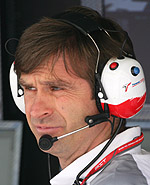 What are the specific technical challenges of Silverstone?
What are the specific technical challenges of Silverstone?
Pascal Vasselon: Silverstone, in fact, presents a thumbprint very similar to Barcelona. In terms of the aerodynamic package we are looking for the same kind of compromise as in Spain. On the tyre side we will be working on the hard side of the Bridgestone range. Perhaps even a little bit harder than in Barcelona probably. For both the aero package and the tyres, the reason why Silverstone looks so similar to Barcelona is that we have many long, high-speed corners. But the Becketts section is especially challenging and different to Barcelona – you don't have those high-speed changes of direction in Barcelona. For that reason we build in a bit more understeer at Silverstone because to achieve decent stability at high speed, you need it. But the tyres don't like that!
What other influences are there?
PV: In terms of braking, Silverstone is quite a low energy circuit and so you try to take some aerodynamic advantage from that with smaller brake ducts. Silverstone will be also give us a good opportunity to assess the new TF106B on a high-speed track compared with the very different conditions we faced in Monte Carlo.
Do you expect to see better results, comparatively, due to the mechanical gains you've made on the TF106B?
PV: We expect to see at Silverstone what we have seen in Paul Ricard, which is the potential to achieve a much better overall balance. And it's impossible to talk about Silverstone without mentioning that we always spend a bit more time on wet strategies...
Ah, the great British weather. A potential problem?
PV: Precisely! We have had a careful selection of wet compounds and we take some time anticipating every kind of wet conditions.
How quick-drying is the Silverstone surface?
PV: It is very difficult to anticipate because the drying rate of a circuit depends a lot on what has happened before as well as the general temperature conditions on a given day. We have seen some very quick drying in the past.
What exactly do you mean by 'what's happened before?'
PV: I'm talking about the previous days and whether it has been very hot or cold. That affects the heat release on the ground and in order to anticipate well the drying rate of the track you have to look at what has happened. It is quite complex actually and explains why we have seen very different drying rates in the past.
Similar in a way, to Spa, where rain is almost a given at some point?
PV: Yes. At Spa last year we gambled on an early change to dry tyres and we unfortunately had a situation where the surface did not dry in a way that reflected things we had seen before at Spa. We had seen the track drying quite quickly in previous Belgian races and even a driver as experienced as Michael Schumacher opted for dry tyres quite early. These are the kind of considerations and strategies that we prepare for Silverstone.
Does the fact that the British Grand Prix has a June date rather than its traditional July make much difference?
PV: It will make rain even more likely!
How far ahead do you look at weather forecasts?
PV: Usually about one week before as regards the temperature. It is possible to be quite accurate about expectations for the temperature range. We will, for example, know one week ahead whether we can expect track temperatures between 20 and 25 degrees or between 30 and 35 degrees. Then, for the predictions about actual rain, we wait until just before the event and sometimes during it. What I've seen in the past with the British teams is that the mechanics calling their wives and friends who live locally to know if the clouds are coming. Although we do have friends, we prefer to rely on our professional weather forecasting equipment!
How big an impact can the driver make at Silverstone?
PV: He will be part of the game, of course, but compared to somewhere like Monaco a driver cannot overcome a car that is not quite right. The car and the aero package play very important roles at Silverstone.
Is overtaking feasible?
PV: It's not easy anywhere in Formula 1 but at Silverstone there are a couple of places where it is possible. For example, the braking area going into Vale, just before Club Corner, can present an opportunity.
How demanding on engines is Silverstone?
PV: Without being a dominant parameter like in Monza or Spa, engine plays an important role in Silverstone with an effect on lap time well above average.
Do the teams look forward to Silverstone?
PV: I've got to say that for us it is pretty much another race on the calendar. Speaking as a Frenchman, it's not a place you go for food or weather!

 What are the specific technical challenges of Silverstone?
What are the specific technical challenges of Silverstone?


















